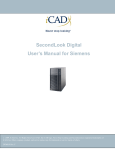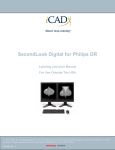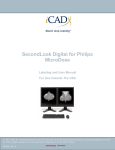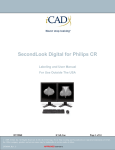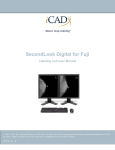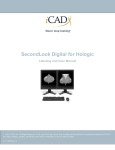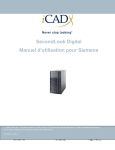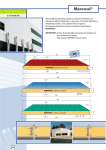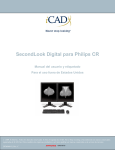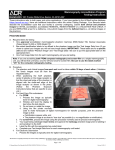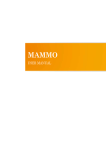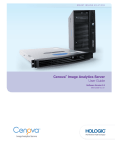Download SecondLook Digital Operators Manual
Transcript
SLD (Giotto) Operator Manual Rev. C SecondLook Digital for Giotto Labeling and User Manual DTM032 Rev. C iCAD, Pagetrademarks 1 of 23 of iCAD, © 2009, iCAD, Inc. All Rights Reserved. iCAD, the iCAD logo, Never StopInc. Looking and SecondLook are registered Inc. Other company, product, and service names may be trademarks or service marks of others. DTM032 Rev. C SLD (Giotto) Operator Manual Rev. C This page intentionally left blank. DTM032 Rev. C iCAD, Inc. Page 2 of 23 SLD (Giotto) Operator Manual Rev. C 98 Spit Brook Rd, Suite 100 Nashua, NH 03062, USA 603 882 5200 The European Representative for iCAD, Inc. is: MDSS GmbH Schiffgraben 41 30175 Hannover, Germany DTM032 Rev. C iCAD, Inc. Page 3 of 23 SLD (Giotto) Operator Manual Rev. C This page intentionally left blank. DTM032 Rev. C iCAD, Inc. Page 4 of 23 SLD (Giotto) Operator Manual Rev. C TABLE OF CONTENTS 1 OVERVIEW OF MANUAL ................................................................................................................... 7 2 SECONDLOOK® DIGITAL IN BREAST CANCER DETECTION....................................................... 7 3 4 5 2.1 BACKGROUND ................................................................................................................................ 7 2.2 DESCRIPTION OF SECONDLOOK® DIGITAL ...................................................................................... 7 SECONDLOOK® DIGITAL DEVICE LABELING................................................................................ 9 3.1 BRIEF DEVICE DESCRIPTION ........................................................................................................... 9 3.2 INDICATIONS FOR USE .................................................................................................................... 9 3.3 CONTRAINDICATIONS .................................................................................................................... 10 3.4 WARNINGS .................................................................................................................................. 10 3.5 PRECAUTIONS .............................................................................................................................. 12 3.6 ADVERSE EFFECTS ...................................................................................................................... 12 3.7 SUMMARY OF CLINICAL STUDIES ................................................................................................... 12 3.8 PRINCIPLES OF OPERATION .......................................................................................................... 14 3.9 CONFORMANCE TO STANDARDS.................................................................................................... 17 3.10 HOW SUPPLIED ............................................................................................................................ 17 RADIOLOGIST USE OF SECONDLOOK® DIGITAL ....................................................................... 17 4.1 RADIOLOGIST REVIEW PRIOR TO VIEWING CAD MARKS................................................................. 17 4.2 RADIOLOGIST REVIEW WITH CAD MARKS...................................................................................... 18 RADIOLOGIST TRAINING WITH SAMPLE CASES ........................................................................ 19 5.1 TRAINING INSTRUCTIONS .............................................................................................................. 19 5.2 SAMPLE CASES ............................................................................................................................ 20 5.2.1 6 Case 1 ................................................................................................................................... 20 SUMMARY OF RADIOLOGIST USE OF SECONDLOOK® DIGITAL ............................................. 23 DTM032 Rev. C iCAD, Inc. Page 5 of 23 SLD (Giotto) Operator Manual Rev. C This page intentionally left blank. DTM032 Rev. C iCAD, Inc. Page 6 of 23 SLD (Giotto) Operator Manual Rev. C 1 Overview of Manual This manual is intended to describe the SecondLook® Digital computer-aided detection algorithms and provide training to radiologists using the SecondLook® Digital system in breast cancer detection. • Section 2 gives an overview of the role of SecondLook® Digital in breast cancer detection. • The SecondLook® Digital Device Labeling is included in section 3, which provides a brief description of the system, indications for use, contraindications, warnings and precautions, adverse effects, summary of clinical studies, a description of the principles of operation for the computer-aided detection (CAD) algorithms, a list of conformance to standards, and how the system is supplied. • The procedures for a radiologist using the SecondLook® Digital CAD marks are described in Section 4. • Sample cases are provided in Section 5 to familiarize the radiologist with the SecondLook® Digital system prior to clinical use. • Section 6 summarizes a radiologist’s use of SecondLook® Digital. 2 SecondLook® Digital in Breast Cancer Detection 2.1 Background SecondLook®, a computer-aided detection (CAD) system for mammography, has been developed by iCAD Inc. to identify and mark regions of interest on screening and diagnostic mammograms to bring them to the attention of radiologists after the initial reading has been completed. Thus, the system assists the radiologist in minimizing observational oversights by identifying areas on the original mammogram that may warrant a second review. The SecondLook® system was first developed for use with screen-film mammography (SFM). For SecondLook® to process full-field digital mammography (FFDM) from the Giotto, a new optional system component has been developed, SecondLook® Digital. SecondLook® Digital can be configured as a stand-alone system that only processes FFDM. 2.2 Description of SecondLook® Digital SecondLook® Digital is a mammographic CAD system that identifies and highlights potential areas of concern to assist radiologists in breast cancer detection. The CAD algorithms used in the SecondLook® Digital computer system include image processing, feature computations, and pattern recognition technology to detect mammographic features indicative of malignancies. Areas of concern marked include suspicious clusters of microcalcifications, spiculated and non-spiculated masses, architectural distortions, DTM032 Rev. C iCAD, Inc. Page 7 of 23 SLD (Giotto) Operator Manual Rev. C and focal asymmetric densities. SecondLook® Digital does not distinguish between benign and malignant processes and may highlight technical artifacts. SecondLook® Digital integrates with the Giotto FFDM system to process FFDM images. The resulting CAD marks are typically displayed overlying the appropriate locations of the mammogram on the review workstation used by the radiologist for softcopy reading. When the CAD marks are displayed within the review workstation, the radiologist can turn on or off the display of CAD marks overlying the mammogram. Although the remainder of this manual is written with the assumption that the CAD marks are viewed on a review workstation, a paper printout of the CAD marks is another possible option. The radiologist using a paper printout follows similar procedures. Typical screening mammography includes four mammographic views: left and right craniocaudal projections (L-CC and R-CC) and left and right mediolateral oblique projections (L-MLO and R-MLO). SecondLook® Digital assists radiologists with these mammographic views and full-breast diagnostic views. On occasion, other views are obtained for screening or diagnostic purposes, such as left and right exaggerated craniocaudal projections rotated laterally (L-XCCL and R-XCCL) and left and right straight mediolateral projections (L-ML and R-ML). When additional screening or diagnostic views are taken, SecondLook® Digital may process more than 4 views for each patient. SecondLook® Digital is not used to assist the radiologist in evaluating magnification/compression views or specimen radiography. For patients with breast implants, SecondLook® Digital is used with implant-displaced views only. When SecondLook® Digital processes magnification/compression views, specimen radiography, or non-displaced implant views, any resulting CAD marks should not be used by the radiologist in evaluating the patient. SecondLook® Digital is intended to be used by a radiologist as follows: The radiologist must first review the mammogram in the normal manner and only afterward consult the CAD marks to determine if SecondLook® Digital has marked any areas of concern that were not observed on the initial review. To view the CAD marks prior to the initial unassisted review of the mammogram risks the so-called satisfaction-of-search error, in which the radiologist’s vigilance for other areas on the mammogram may be lowered by virtue of seeing one or more areas highlighted by SecondLook® Digital. The absence of a CAD mark at a lesion initially detected without the assistance of SecondLook® Digital should not be used by the radiologist to override the decision to further evaluate the lesion. SecondLook® Digital is designed to mark areas with the mammographic appearance of cancer; however, many of the marked areas will not contain a malignancy, and it is up to the radiologist to decide, using conventional clinical judgment and reviewing the mammogram itself, if the area is suspicious enough to warrant further work-up. SecondLook® Digital is not a diagnostic device, as the CAD marks are intended to be used to assist only in detection and not in interpretation. Therefore, SecondLook® Digital can assist a radiologist in detecting areas of concern that would have been missed without its use, but used properly it cannot cause a radiologist to miss areas of concern that would have been detected without SecondLook® Digital. SecondLook® Digital was developed by leaders in the fields of image processing and artificial intelligence. Below is a description of how SecondLook® Digital’s computeraided detection (CAD) works. DTM032 Rev. C iCAD, Inc. Page 8 of 23 SLD (Giotto) Operator Manual Rev. C 1. The Giotto full-field digital mammograms are processed by the system. Image processing is used to identify all the potential cancerous locations in the image. 2. These locations are analyzed using radiologic and proprietary measures as well as a feature selection process to determine the most likely locations to be cancer. 3. The most likely locations are evaluated in the context of the patient, and highlighted with CAD marks displayed overlying the mammograms on the review workstation used by the radiologist for softcopy reading. It is important to remember that SecondLook® Digital will not necessarily mark what a radiologist would work-up. This is an important consideration as every radiologist worksup different areas based on her or his own criteria. SecondLook® Digital does not function on its own, but always with a radiologist. Therefore, if SecondLook® Digital highlights a mass or microcalcifications in one view only, the radiologist can look for it in the other view to determine if there is a lesion that warrants work-up. 3 SecondLook® Digital Device Labeling 3.1 Brief Device Description SecondLook® is a mammographic computer-aided detection (CAD) system that identifies and highlights potential areas of concern to assist radiologists in breast cancer detection. The CAD algorithms used in the SecondLook® computer system include image processing, feature computations, and pattern recognition technology to detect mammographic features indicative of malignancies. Areas of concern identified include suspicious clusters of microcalcifications, spiculated and non-spiculated masses, architectural distortions, and focal asymmetric densities. SecondLook® is intended to be used by a radiologist as follows: The radiologist must first review the mammogram in the normal manner and only afterward consult the CAD marks to determine if SecondLook® has marked any areas of concern that were not observed on the initial review. SecondLook® is designed to mark areas with the mammographic appearance of cancer; however, many of the marked areas will not contain a malignancy, and it is up to the radiologist to decide, using conventional clinical judgment and reviewing the mammogram itself, if the area is suspicious enough to warrant further work-up. SecondLook® is not a diagnostic device, as the CAD marks are intended to be used to assist only in detection and not in interpretation. 3.2 Indications for Use The SecondLook® Digital computer-aided detection system for mammography is intended to identify and mark regions of interest on screening and diagnostic mammograms from the Giotto full-field digital mammography system to bring them to the attention of the radiologist after the initial reading has been completed. Thus, the system assists the radiologist in DTM032 Rev. C iCAD, Inc. Page 9 of 23 SLD (Giotto) Operator Manual Rev. C minimizing observational oversights by identifying areas on the original mammogram that may warrant a second review. 3.3 Contraindications There are no contraindications for use of this device. 3.4 Warnings Warnings: Radiological Interpretation • The SecondLook® system assists in breast cancer detection, not interpretation or diagnosis. • Upon re-evaluation of the Giotto full-field digital mammography images at the locations of the CAD marks, the radiologist uses interpretive skills to determine if the area should be worked-up based on its mammographic appearance. • The initial, unassisted review of Giotto full-field digital mammography images is critical, because the system will not highlight all areas that the radiologist may detect, and using the system before finishing the unassisted conventional image review runs the risk of inducing a so-called satisfaction-of-search error, in which the radiologist fails to examine the unmarked areas of the images with adequate vigilance. • • The system is not designed to highlight interval change between mammographic exams. • The system is not designed to highlight asymmetric breast tissue, tubular density/solitary dilated duct, skin thickening, or nipple retraction. The SecondLook® system will highlight areas that a radiologist determines do not require work-up. Thus, the work-up is determined by the radiologist, and the presence of a CAD mark should not influence the decision that would have been made had the area been noted in the first place. • • The radiologist must still use diagnostic skills to differentiate benign from malignant lesions by working-up the area, which may include magnification/spot mammography, ultrasound, or interventional procedures. Therefore, the radiologist’s work-up decision should not be altered if the system fails to mark an area that the radiologist has detected on the initial image review and has already decided requires further work-up. Nor should the decision be affected if the system marks an area that the radiologist decides is not suspicious enough to warrant further work-up, whether the area is detected by the radiologist on initial image review or only after being marked by the system. DTM032 Rev. C iCAD, Inc. Page 10 of 23 SLD (Giotto) Operator Manual • Rev. C Effectiveness and safety have not been established for non-standard mammographic views (e.g., magnification/compression views) or non-displaced implant views. Therefore, any CAD marks in these views should not be used by the radiologist in evaluating the patient. Warnings: System Operation • The system should not be used if it is suspected that any electrical component is defective or inoperable. • Do not place any liquids on or near SecondLook®. If a liquid is accidentally spilled on electrical components, immediately turn off the Uninterruptible Power Supply (UPS), which will automatically shut down the system to prevent any potential electrical shock. Contact your authorized SecondLook® service provider for further instructions. • Ensure that the system is connected to a properly wired and grounded power receptacle. Confirm that the voltage and current requirements are within system specifications to avoid bodily injury from electrical shock or fire hazard. Warnings: Installation and Maintenance • Modem Warning -- The modem is to be used by service personnel only in case the system requires remote servicing. • EMC Warning -- This SecondLook® system has been tested and found to comply with EN 60601-1-2. Compliance with EN 60601-1-2 shows the system is reasonably protected against harmful interference in a typical medical installation. However, this system generates, uses and can radiate radio frequency energy and, if not installed and used in accordance with instructions, may cause or be subject to harmful interference with other devices in the vicinity. If the SecondLook® system appears to cause or be subject to harmful interference, try the following steps to correct the problem: • • • • Reorient or relocate the SecondLook® system or the interfering device. Increase the separation between the SecondLook® system and the interfering device. Plug the SecondLook® system into an outlet on a different circuit from the interfering device. Contact your authorized SecondLook® field service provider for further instructions. • Uninterruptible Power Supply Warning -- Persons performing troubleshooting or maintenance on the equipment should be aware and cautioned that the Uninterruptible Power Supply (UPS) continues to provide electrical energy during power failures and when disconnected from the main power. • Temperature and Humidity Warning -- SecondLook® system operations must be performed within the following temperature and humidity ranges. • • Temperature: 50°-95° Fahrenheit (10°-35° Celsius) Humidity: 20-80% DTM032 Rev. C iCAD, Inc. Page 11 of 23 SLD (Giotto) Operator Manual 3.5 Rev. C Precautions Precautions: System Operation • The SecondLook® system is protected by an Uninterruptible Power Source (UPS). When power is lost, the unit beeps constantly for five minutes, and the SecondLook® system will automatically shut down. The beep indicates that the power source is protecting the equipment after a loss of power. • To prevent damage to the system, maintain equipment in a well-ventilated, air-conditioned environment. • Only images from a Giotto full-field digital mammography system that is maintained in accordance with MQSA standards should be used. • Effectiveness and safety in patients with breast implants has not been established for views that include the implant. When implant-displaced views are analyzed by the system, any resulting CAD marks should not be used by the radiologist in evaluating the patient. • Effectiveness and safety have not been established for non-standard mammographic views (e.g., magnification/compression views). When these views are analyzed by the system, any resulting CAD marks should not be used by the radiologist in evaluating the patient. Precautions: Installation and Maintenance • This product contains no independently user serviceable parts. To prevent damage to the system, do not attempt to install or repair the SecondLook® system. Only trained personnel are qualified to install or repair the system. For service training, contact iCAD Inc. at 1-866280-2239. • Disconnect power cord before moving or servicing. 3.6 Adverse Effects The use of SecondLook® adds no known additional risks to mammography. There is no direct contact with the patient. 3.7 Summary of Clinical Studies A variety of studies have been performed in order to achieve regulatory approval. Below is a summary of the studies. More information can be obtained by contacting iCAD. Conclusions drawn from the studies: DTM032 Rev. C iCAD, Inc. Page 12 of 23 SLD (Giotto) Operator Manual Rev. C • The use of the SecondLook® Analog medium system led to a clinically significant reduction in missed cancers of at least 27.1% (95% CI 22.1% – 32.0%). • A retrospective study of 374 cancer cases showed that 21.9% (95% CI, 17.9% – 25.9%) of women diagnosed with breast cancer, who had prior screening mammograms within 9 – 24 months of diagnosis, could have had their cancers discovered earlier, by an average of 15.1 months, with the use of SecondLook® Analog medium. • The use of the SecondLook® Analog system led to an insignificant increase in the number of work-ups recommended by radiologists reading screening mammograms from 16.6% (95% CI 15.5% – 17.8%) unaided to 17.2% (95% CI 16.0% – 18.4%) aided by the system. • The sensitivity of SecondLook® Digital with input from the Giotto full-field digital mammography system was statistically no different than the sensitivity of SecondLook® Analog medium with input from screen-film mammography. • The false positive rate of SecondLook® Digital with input from the Giotto full-field digital mammography system was statistically no different than the false positive rate of SecondLook® Analog medium with input from screen-film mammography. • The study with SecondLook® Digital did not assess the impact of this system on reduction in missed cancers, percent of women who could have had their cancers discovered earlier, and work-up rate. In summary, the SecondLook® system will enhance a radiologist’s effectiveness in detecting breast cancer. DTM032 Rev. C iCAD, Inc. Page 13 of 23 SLD (Giotto) Operator Manual 3.8 Rev. C Principles of Operation SecondLook® uses computer-aided detection (CAD) algorithms to identify suspicious lesions in mammograms. The Giotto full-field digital mammography system creates digital mammographic images that are input to SecondLook®, and these CAD algorithms use advanced image processing, feature computations, and pattern recognition technology to analyze the images for potential areas of concern. These potential areas of concern are displayed for the radiologist by overlying CAD marks at the appropriate locations of the Giotto full-field digital mammography images within the softcopy review workstation or on a paper printout. The CAD marks are used by the radiologist as an additional tool in breast cancer detection. An overview of the SecondLook® CAD algorithms is shown in Figure 1 Standard Mammography Films MicroCalc Algorithm Density Algorithm Calc Image Enhancement Density Image Enhancement MicroCalc Detector Density Detector Clustering Region Growing MicroCalc Classifier Density Classifier Context Based Patient Evaluation Areas of Concern Highlighted by CAD Marks Figure 1: SecondLook® CAD Algorithms Overview DTM032 Rev. C iCAD, Inc. Page 14 of 23 SLD (Giotto) Operator Manual Rev. C The CAD algorithms begin with image enhancement of the digitized mammographic images to accentuate all areas that could be individual microcalcifications and densities. The microcalcification and density detectors then identify the areas that are most likely to be individual microcalcifications and densities, based on an initial analysis of Giotto data and intensity measurements. The types of densities detected are depicted in Figure 2 and include spiculated and non-spiculated masses, architectural distortions, and focal asymmetric densities. Circumscribed Masses Round Microlobulated Mass Oval Obscured Mass Spiculated Mass Lobular Irregular Mass with Indistinct Margins Architectural Distortion NOTE: Focal asymmetric densities are difficult to depict pictorially, but are detected by SecondLook® Figure 2: Densities Detected by SecondLook® Further analysis of detected areas is accomplished by clustering individual microcalcifications and region growing densities. Clusters include 3 or more individual microcalcifications that are each no more than 4.1 millimeters apart. Figure 3 depicts portions of three different Giotto full-field digital mammography images showing how the SecondLook® system would highlight microcalcifications clusters in these examples. These examples use CAD marks that are rectangular and correspond to the approximate DTM032 Rev. C iCAD, Inc. Page 15 of 23 SLD (Giotto) Operator Manual Rev. C size of the microcalcifications, although alternative symbols for the CAD marks may be used. Region growing determines the shape of potential densities as shown in Figure 4. c) b) a) 4.1mm 4.1mm Figure 3: CalcMarks Highlighting Microcalcifications Clusters with: a) The minimum number of calcifications b) The extent of the CalcMark enclosing all calcifications considered as part of the cluster c) Overlapping CalcMarks are distinctly highlighted even when clusters are close to each other After clustering for microcalcifications analysis and region growing for density analysis, clinically relevant and mathematical features are then computed to describe each detected cluster of microcalcifications and density. For example, the variability in size and shape of the calcifications in a cluster are good features to describe clusters of microcalcifications. These features are used by microcalcifications and density classifiers, which are specifically designed to select the areas most likely to be cancer. Further analysis uses the context of all areas selected for the patient. For example, there is a maximum total number of SecondLook® CAD marks each 4-image case can include. Simultaneous analysis of all areas of concern detected in the patient allows the locations most likely to be cancer to be highlighted by the CAD marks. DTM032 Rev. C iCAD, Inc. Page 16 of 23 SLD (Giotto) Operator Manual Rev. C Figure 4: Region Growing to Determine Shape of Density 3.9 Conformance to Standards Refer to the SecondLook® Digital Service Manual for the CE Declaration of Conformity. 3.10 How Supplied The SecondLook® system includes the following components: • Uninterruptible Power Supply • Computer 4 Radiologist Use of SecondLook® Digital 4.1 Radiologist Review Prior to Viewing CAD Marks The radiologist first reviews the Giotto full-field digital mammograms without viewing the SecondLook® Digital CAD marks, following her or his existing procedures of clinical practice. The radiologist will make an initial determination if a work-up is indicated for the patient prior to turning on and viewing the CAD marks with the softcopy review workstation. DTM032 Rev. C iCAD, Inc. Page 17 of 23 SLD (Giotto) Operator Manual 4.2 Rev. C Radiologist Review with CAD Marks The radiologist turns on and views the SecondLook® Digital CAD marks with the softcopy review workstation after determining whether or not a work-up is indicated from her or his initial review of the patient mammograms. The radiologist will “take a SecondLook®” at the mammograms corresponding to any CAD marks. From this re-evaluation of the mammograms, the radiologist determines if any additional work-up is required. If there are no CAD marks, no re-evaluation of the mammograms is necessary. Work-up decisions are not based solely upon the CAD marks. All work-up decisions are based upon review of the mammograms, supporting clinical information, and CAD marks by the radiologist. Areas of concern marked by SecondLook® Digital include suspicious clusters of microcalcifications, spiculated and non-spiculated masses, architectural distortions, and focal asymmetric densities. Below is the recommended case review process with SecondLook® Digital: 1. Review patient history and evaluate Giotto full-field digital mammograms prior to turning on and viewing CAD marks with softcopy review workstation 2. Make initial interpretation 3. Turn on and view CAD marks with softcopy review workstation and identify potential areas of concern 4. Review mammograms, re-evaluating areas of concern highlighted by CAD marks with softcopy review workstation 5. Render decision It is very important to remember that it is the radiologist who makes the final decision about a case. When a radiologist decides to work-up a case, the CAD marks must not change the decision; however, the CAD marks can identify locations for further work-up that were initially undetected by the radiologist. DTM032 Rev. C iCAD, Inc. Page 18 of 23 SLD (Giotto) Operator Manual Rev. C 5 Radiologist Training with Sample Cases 5.1 Training Instructions One sample case demonstrates the use of SecondLook® Digital for the radiologist prior to clinical use. This case is intended to familiarize the radiologist with the procedures for using the SecondLook® Digital CAD marks. The case review procedures are emphasized. Therefore, the training is accomplished by following the case presentation in Section 5.2 of this manual, without requiring use of the softcopy review station. For the example case in the manual, the procedures for using SecondLook® Digital CAD marks are demonstrated to the radiologist with the following steps: 1. The first page will provide the case history and printed versions of the Giotto full-field digital mammograms without CAD marks. During clinical use, the radiologist would first review the mammograms without viewing the CAD marks, following her or his existing procedures of clinical practice. The radiologist would make an initial determination if a work-up were indicated for the patient prior to turning on and viewing the CAD marks with the softcopy review workstation. 2. The second page contains printed versions of the mammograms with CAD marks turned on. During clinical use, the radiologist would “take a SecondLook®” at the mammograms corresponding to any CAD marks. From this re-evaluation of the mammograms, the radiologist would determine if any additional work-up was required. If there were no CAD marks, no re-evaluation of the mammograms would be necessary. Work-up decisions are not based solely upon the CAD marks. All work-up decisions are based upon review of the mammograms, supporting clinical information, and CAD marks by the radiologist. 3. The third page then presents a summary of the case, which includes the case history, the mammographic findings, and the resulting pathology. An arrow points to the location of the tumor in printed versions of the mammograms. DTM032 Rev. C iCAD, Inc. Page 19 of 23 SLD (Giotto) Operator Manual 5.2 5.2.1 Rev. C Sample Cases Case 1 Case History and Mammograms – Case 1 History: 62 yo female with palpable mass in upper outer quadrant of right breast. No family history of breast cancer. **** **** DURING CLINICAL USE, THE INITIAL MAMMOGRAPHY REVIEW AND INITIAL WORK-UP DECISION WOULD BE ACCOMPLISHED DTM032 Rev. C iCAD, Inc. **** **** Page 20 of 23 SLD (Giotto) Operator Manual Rev. C Mammograms with CAD Marks – Case 1 Note: The softcopy review workstation may use symbols other than rectangles (calcifications) and ellipses (masses) for the CAD marks. **** **** **** **** **** DURING CLINICAL USE, THE AREAS OF CONCERN HIGHLIGHTED BY THE CAD MARKS WOULD BE RE-EVALUATED USING THE SOFTCOPY REVIEW WORKSTATION. FROM THIS RE-EVALUATION OF THE MAMMOGRAMS, THE RADIOLOGIST MAKES THE FINAL WORK-UP DECISION. DTM032 Rev. C iCAD, Inc. **** **** **** **** **** Page 21 of 23 SLD (Giotto) Operator Manual Rev. C Case Summary – Case 1 History: 62 yo female with palpable mass in upper outer quadrant of right breast. No family history of breast cancer. Mammographic findings: 3 cm circumscribed mass with partially obscured borders in the right breast at 10 o’clock (shown to be a cyst on ultrasound). Linear distribution of pleomorphic calcifications in the right breast at 2 o’clock posteriorly. Pathology: Ductal carcinoma in-situ (arrows show location). DTM032 Rev. C iCAD, Inc. Page 22 of 23 SLD (Giotto) Operator Manual Rev. C 6 Summary of Radiologist Use of SecondLook® Digital The radiologist uses the SecondLook® Digital CAD marks with mammography according to the following steps: 1) The radiologist first reviews the Giotto full-field digital mammograms without viewing the CAD marks, following her or his existing procedures of clinical practice. The radiologist will make an initial determination if a work-up is indicated for the patient prior to turning on and viewing the CAD marks with the softcopy review workstation. 2) The radiologist turns on and views the CAD marks with the softcopy review workstation after determining whether or not a work-up is indicated from her or his initial review of the patient mammograms. 3) The radiologist will “take a SecondLook®” at the mammograms corresponding to any CAD marks. From this re-evaluation of the mammograms, the radiologist determines if any additional work-up is required. If there are no CAD marks, no re-evaluation of the mammograms is necessary. Work-up decisions are not based solely upon the CAD marks. All work-up decisions are based upon review of the mammograms, supporting clinical information, and CAD marks by the radiologist. DTM032 Rev. C iCAD, Inc. Page 23 of 23























